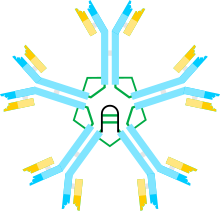The fifth type of hyper-IgM syndrome has been characterized in three patients from France and Japan. The symptoms are similar to hyper IgM syndrome type 2, but the AICDA gene is intact.[8]
| Hyper IgM syndrome type 5 | |
|---|---|
 | |
| Immunoglobulin M | |
| Symptoms | Chronic diarrhea[1] |
| Types | Hyper-IgM syndrome type 1,2,3,4 and 5[2][3][4][5][6] |
| Diagnostic method | MRI, Chest radiography and genetic testing[1] |
| Treatment | Allogeneic hematopoietic cell transplantation[7] |
These three patients instead had mutations in the catalytic domain of uracil-DNA glycosylase, an enzyme that removes uracil from DNA. In hyper-IgM syndromes, patients are deficient in the immunoglobulins, IgG, IgE and IgA types since the antibody producing B cells can not carry out the gene recombination steps necessary to class switch from immunoglobulin M (IgM) to the other three immunoglobulins types.
Hyper IgM syndromes
editHyper IgM syndromes is a group of primary immune deficiency disorders characterized by defective CD40 signaling; via B cells affecting class switch recombination (CSR) and somatic hypermutation. Immunoglobulin (Ig) class switch recombination deficiencies are characterized by elevated serum IgM levels and a considerable deficiency in Immunoglobulins G (IgG), A (IgA) and E (IgE). As a consequence, people with HIGM have an increased susceptibility to infections.[9][7][10]
Signs and symptoms
editHyper IgM syndrome can have the following syndromes:[1][11]
- Infection/Pneumocystis pneumonia (PCP), which is common in infants with hyper IgM syndrome, is a serious illness.[9] PCP is one of the most frequent and severe opportunistic infections in people with weakened immune systems.
- Hepatitis (Hepatitis C)
- Chronic diarrhea
- Hypothyroidism
- Neutropenia
- Arthritis
- Encephalopathy (degenerative)
Cause
editDifferent genetic defects cause HIgM syndrome, the vast majority are inherited as an X-linked recessive genetic trait and most with the condition are male.[7][2][3][4][12][5]
IgM is the form of antibody that all B cells produce initially before they undergo class switching. Healthy B cells efficiently switch to other types of antibodies as needed to attack invading bacteria, viruses, and other pathogens. In people with hyper IgM syndromes, the B cells keep making IgM antibodies because can not switch to a different antibody. This results in an overproduction of IgM antibodies and an underproduction of IgA, IgG, and IgE.[13][7]
Pathophysiology
editCD40 is a costimulatory receptor on B cells that, when bound to CD40 ligand (CD40L), sends a signal to the B-cell receptor.[14] When there is a defect in CD40, this leads to defective T-cell interaction with B cells. Consequently, humoral immune response is affected. Patients are more susceptible to infection.[1]
Diagnosis
editThe diagnosis of hyper IgM syndrome can be done via the following methods and tests:[1]
- MRI
- Chest radiography
- Pulmonary function test
- Lymph node test
- Laboratory test (to measure CD40)
Treatment
editIn terms of treatment for hyper IgM syndrome, there is the use of allogeneic hematopoietic cell transplantation. Additionally, anti-microbial therapy, use of granulocyte colony-stimulating factor, immunosuppressants, as well as other treatments, may be needed.[7]
References
edit- ^ a b c d e "X-linked Immunodeficiency With Hyper IgM Clinical Presentation: History, Physical, Causes". emedicine.medscape.com. Retrieved 27 November 2016.
- ^ a b "OMIM Entry – # 308230 – IMMUNODEFICIENCY WITH HYPER-IgM, TYPE 1; HIGM1". omim.org. Retrieved 16 November 2016.
- ^ a b "OMIM Entry – # 605258 – IMMUNODEFICIENCY WITH HYPER-IgM, TYPE 2; HIGM2". omim.org. Retrieved 16 November 2016.
- ^ a b "OMIM Entry – # 606843 – IMMUNODEFICIENCY WITH HYPER-IgM, TYPE 3; HIGM3". omim.org. Retrieved 16 November 2016.
- ^ a b "OMIM Entry – # 608106 – IMMUNODEFICIENCY WITH HYPER-IgM, TYPE 5; HIGM5". omim.org. Retrieved 16 November 2016.
- ^ "OMIM Entry – 608184 – IMMUNODEFICIENCY WITH HYPER-IgM, TYPE 4; HIGM4". omim.org. Retrieved 2 January 2018.
- ^ a b c d e Johnson, Judith; Filipovich, Alexandra H.; Zhang, Kejian (1 January 1993). "X-Linked Hyper IgM Syndrome". GeneReviews. PMID 20301576. Retrieved 12 November 2016.update 2013
- ^ "OMIM Entry – # 608106 – IMMUNODEFICIENCY WITH HYPER-IgM, TYPE 5; HIGM5". omim.org. Retrieved 27 June 2017.
- ^ a b Etzioni, Amos; Ochs, Hans D. (1 October 2004). "The Hyper IgM Syndrome—An Evolving Story". Pediatric Research. 56 (4): 519–525. doi:10.1203/01.PDR.0000139318.65842.4A. ISSN 0031-3998. PMID 15319456.
- ^ "Hyper-Immunoglobulin M (Hyper-IgM) Syndromes | NIH: National Institute of Allergy and Infectious Diseases". niaid.nih.gov. Retrieved 27 November 2016.
- ^ Davies, E Graham; Thrasher, Adrian J (27 November 2016). "Update on the hyper immunoglobulin M syndromes". British Journal of Haematology. 149 (2): 167–180. doi:10.1111/j.1365-2141.2010.08077.x. ISSN 0007-1048. PMC 2855828. PMID 20180797.
- ^ Lougaris V, Badolato R, Ferrari S, Plebani A (2005). "Hyper immunoglobulin M syndrome due to CD40 deficiency: clinical, molecular, and immunological features". Immunol. Rev. 203: 48–66. doi:10.1111/j.0105-2896.2005.00229.x. PMID 15661021. S2CID 6678540.subscription needed
- ^ Reference, Genetics Home. "X-linked hyper IgM syndrome". Genetics Home Reference. Retrieved 27 November 2016.
- ^ Reference, Genetics Home. "CD40 gene". Genetics Home Reference. Retrieved 27 November 2016.